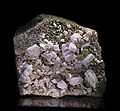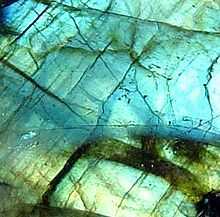Plagioclase
| Plagioclase | |
|---|---|
 A photomicrograph of a plagioclase crystal under cross polarized light. The plagioclase crystal shows a distinct banding effect called a Polysynthetic twinning. | |
| General | |
| Category | Feldspar mineral group, tectosilicate |
| Formula (repeating unit) | NaAlSi3O8 – CaAl2Si2O8 |
| Crystal symmetry |
Triclinic pinacoidal H-M symbol: (1) Space group: C1 |
| Identification | |
| Color | White, gray, bluish white, reddish white, greenish white |
| Crystal habit | Massive to granular |
| Crystal system | Triclinic |
| Twinning | Common, albite law striations on {001}[1] |
| Cleavage | Good on {001} and {010} |
| Tenacity | Brittle |
| Mohs scale hardness | 6 - 6.5 |
| Luster | Vitreous |
| Streak | White |
| Diaphaneity | Transparent to translucent |
| Specific gravity | 2.62 (albite) to 2.76 (anorthite)[1] |
| Optical properties | Biaxial (+) albite, biaxial (-) anorthite[1] |
| Refractive index |
Albite: nα 1.527, nβ 1.532 nγ 1.538 Anorthite: nα 1.577 nβ 1.585 nγ 1.590[1] |
| Solubility | Albite insoluble in HCl, anorthite decomposed by HCl [1] |
| References | [2] |


Plagioclase is an important series of tectosilicate minerals within the feldspar family. Rather than referring to a particular mineral with a specific chemical composition, plagioclase is a solid solution series, more properly known as the plagioclase feldspar series (from the Greek "oblique fracture", in reference to its two cleavage angles). This was first shown by the German mineralogist Johann Friedrich Christian Hessel (1796–1872) in 1826. The series ranges from albite to anorthite endmembers (with respective compositions NaAlSi3O8 to CaAl2Si2O8), where sodium and calcium atoms can substitute for each other in the mineral's crystal lattice structure. Plagioclase in hand samples is often identified by its polysynthetic twinning or 'record-groove' effect.
Plagioclase is a major constituent mineral in the Earth's crust, and is consequently an important diagnostic tool in petrology for identifying the composition, origin and evolution of igneous rocks. Plagioclase is also a major constituent of rock in the highlands of the Earth's moon.
Plagioclase series members
The composition of a plagioclase feldspar is typically denoted by its overall fraction of anorthite (%An) or albite (%Ab), and readily determined by measuring the plagioclase crystal's refractive index in crushed grain mounts, or its extinction angle in thin section under a polarizing microscope. The extinction angle is an optical characteristic and varies with the albite fraction (%Ab). There are several named plagioclase feldspars that fall between albite and anorthite in the series. The following table shows their compositions in terms of constituent anorthite and albite percentages.
| Name | % An | % Ab |
|---|---|---|
 | 90–100 | 10–0 |
 | 70–90 | 30–10 |
 | 50–70 | 50–30 |
 | 30–50 | 70–50 |
 | 10–30 | 90–70 |
 | 0–10 | 100–90 |
Endmembers
- Anorthite: Anorthite was named by Rose in 1823 from the Greek meaning oblique, referring to its triclinic crystallization. Anorthite is a comparatively rare mineral but occurs in the basic plutonic rocks of some orogenic calc-alkaline suites.
- Albite: Albite is named from the Latin albus, in reference to its unusually pure white color. It is a relatively common and important rock-making mineral associated with the more acid rock types and in pegmatite dikes, often with rarer minerals like tourmaline and beryl.
Intermediate members
The intermediate members of the plagioclase group are very similar to each other and normally cannot be distinguished except by their optical properties.
- Bytownite: Bytownite, named after the former name for Ottawa, Canada (Bytown), is a rare mineral occasionally found in more basic rocks.

- Labradorite: Labradorite is the characteristic feldspar of the more basic rock types such as diorite, gabbro, andesite, or basalt and is usually associated with one of the pyroxenes or amphiboles. Labradorite frequently shows an iridescent display of colors due to light refracting within the lamellae of the crystal. It is named after Labrador, where it is a constituent of the intrusive igneous rock anorthosite which is composed almost entirely of plagioclase. A variety of labradorite known as spectrolite is found in Finland.
- Andesine: Andesine is a characteristic mineral of rocks such as diorite which contain a moderate amount of silica and related volcanics such as andesite.
- Oligoclase: Oligoclase is common in granite, syenite, diorite, and gneiss. It is a frequent associate of orthoclase. The name oligoclase is derived from the Greek for little and fracture, in reference to the fact that its cleavage angle differs significantly from 90°. Sunstone is mainly oligoclase (sometimes albite) with flakes of hematite.
See also
References
- ↑ 1.0 1.1 1.2 1.3 1.4 Klein, Cornelis and Cornelius S. Hurbut, Jr.; Manual of Mineralogy, Wiley, 20th ed., 1980, pp.454-456 ISBN 0-471-80580-7
- ↑ Webmineral data
| Wikimedia Commons has media related to Plagioclase. |
| Look up plagioclase in Wiktionary, the free dictionary. |